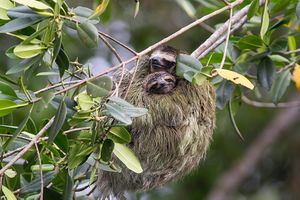Sloth evolution
Introduction
There are two families of sloths, the two-toed sloth and the three-toed sloth, but there are six different species total. Two-toed sloths belong to the genus Choloepus and three-toed sloths belong to the genus Bradypus. Known for their slow movements and inefficient digestive systems, these creatures populate South American and Central American rainforests. Their diets mainly consist of leaves and fruits. All species of sloths spend their time in the rainforest canopy, spending between 15-20 hours a day sleeping, and only venturing to the floor in order to defecate. The forest floor is full of predators that sloths mainly avoid by hiding in the forest canopy. Their slow movements are due to their extremely slow metabolism, as they attempt to conserve energy by controlling movement speed.
Select a topic about genetics or evolution in a specific organism or ecosystem.
The topic must include one section about microbes (bacteria, viruses, fungi, or protists). This is easy because all organisms and ecosystems have microbes.
Compose a title for your page.
Type your exact title in the Search window, then press Go. The MicrobeWiki will invite you to create a new page with this title.
Open the BIOL 116 Class 2019 template page in "edit."
Copy ALL the text from the edit window.
Then go to YOUR OWN page; edit tab. PASTE into your own page, and edit.

At right is a sample image insertion. It works for any image uploaded anywhere to MicrobeWiki. The insertion code consists of:
Double brackets: [[
Filename: PHIL_1181_lores.jpg
Thumbnail status: |thumb|
Pixel size: |300px|
Placement on page: |right|
Legend/credit: Electron micrograph of the Ebola Zaire virus. This was the first photo ever taken of the virus, on 10/13/1976. By Dr. F.A. Murphy, now at U.C. Davis, then at the CDC.
Closed double brackets: ]]
Other examples:
Bold
Italic
Subscript: H2O
Superscript: Fe3+
Section 1 Genetics
Include some current research, with at least one image.
Sample citations: [1]
[2]
A citation code consists of a hyperlinked reference within "ref" begin and end codes.
Despite the similarities between Bradypus and Choloepus appear very small, they actually evolved through convergent evolution. This is where organisms with different ancestors or from different times evolved similar phenotypical traits.
Section 2 Microbiome
Include some current research, with a second image.
Conclusion
Overall text length should be at least 1,000 words (before counting references), with at least 2 images. Include at least 5 references under Reference section.
References
Edited by Cassandra Lis, student of Joan Slonczewski for BIOL 116 Information in Living Systems, 2019, Kenyon College.
